Nintendo opened their Switch 2 Direct with Mario Kart World, a wide-open racer that arrives some 11 years after the last mainline series entry. As the Switch 2’s premier launch title, it carries huge expectations. What can we learn about the game and its tech from what’s been revealed so far?
Before we get into Mario Kart World itself, I think a quick overview of Mario Kart 8 is necessary, because the prior game informs a lot of World’s rendering choices. Mario Kart 8 runs at 720p on Wii U and up to 1080p on Switch, both at high frame-rates, which required some key technical compromises.
Chief among them is the extensive use of baked lighting; most of the game’s direct and indirect lighting is pre-calculated and stored in lightmaps and ambient occlusion maps. This performance-saving measure allows MK8 to feature relatively sophisticated lighting, though its low resolution does stick out sometimes.
Environmental detail looks great when moving at fast speed, but the game isn’t necessarily throwing a ton of geometry around and it doesn’t have super-sophisticated materials either. Most surfaces appear pretty diffuse, with shiny and normal-mapped surfaces in the mix as needed. Specular detail in MK8 is also fairly simple. There’s no SSR here, given the game’s vintage, with shiny surfaces instead relying on rougher static cubemaps. Water surfaces generally look quite transparent even at steep angles too, likely for gameplay reasons.
When we move over to Mario Kart World, the key innovation is its open-world gameplay structure and larger 24 player races. Players seem free to roam just about anywhere on the map when not racing, and events have extensive off-circuit sections too. Perhaps as a result of this grander scope, some of the same rendering choices end up in World too.
Trackside lighting still relies on a lot of baking, for instance. A larger number of dynamic objects like flags and breakable lightposts use real-time shadowing instead, but the environmental lighting is still heavily pre-calculated. World apparently features some kind of real-time day/night cycle and weather, and times of day do change throughout races, but the position of the primary light source remains static, so even when the sun is low in the evening sky, the shadows are permanently set at a kind of mid-afternoon angle.
Environments mostly look great when you are blasting past at high speed, though a closer inspection reveals fairly judicious placement of polygons. During free roam gameplay, where the pace of play is much more relaxed, some of these compromises become a little more noticeable. Perhaps this is engineered to keep level of detail pop-in to a minimum, as level-of-detail shifts are fairly minimal and not very noticeable during gameplay. Interestingly, building interiors seem to have real depth and parallax, though they appear fairly simple and often repeat.
If you look a little deeper, you can spot some considerable rendering improvements in the mix here as well – which ultimately make the game look substantially better than its predecessor. World has some excellent-looking water rendering, with foaming waves and lots of geometric undulation. When you hit water, the player vehicle changes into an aquatic alternative and you drive on the water’s surface, unlike in Mario Kart 8 where you simply rode the track beneath the waves. As a result, the reflection tech has evolved, and seems to be possibly using a planar reflection technique.
There are some tells here that indicate we aren’t looking at screen-space reflections or even something ray-traced, like alignment issues and the fact that player vehicles aren’t reflected. At the same time though, the reflections match the scene too well to simply be a pre-calculated cubemap, which would probably look pretty bad on larger bodies of water. It seems that other glossy surfaces do rely on cubemaps though.
Materials quality also seems to have taken a step up here. Surfaces have higher-detail textures, including better normal maps, and appear more natural. World’s world often looks worn, with cracked pavement and faded, uneven paint, while Mario Kart 8 tended to have a more sterile look. Some shaders, like the one used to simulate ice, produce a more visually sophisticated appearance and more closely mimic their real-world inspiration.
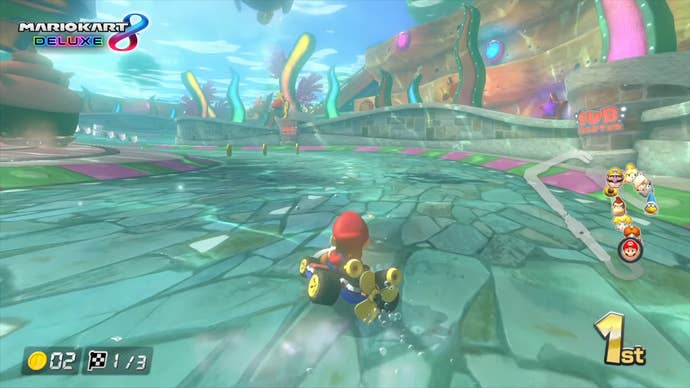
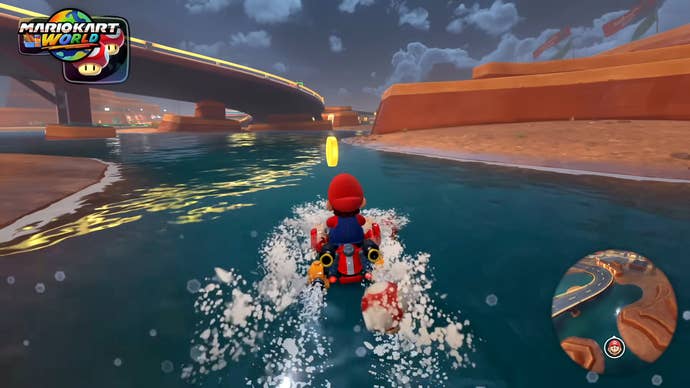
We actually have footage of the one track that is returning from Mario Kart 8, which is Sky-High Sundae. A side-by-side reveals much better looking artwork that clearly has seen a lot more time and attention. However, I don’t want to put too much stock into this admittedly stark comparison, because this is a track from the Booster Course Pass which had a more basic appearance with the mobile game Mario Kart Tour in mind. Model detail and art quality both took a big hit with these tracks, so it’s not surprising that a proper art pass has produced a markedly better-looking result.
Characters also typically appear quite different in this new Mario Kart outing. This is evident right from the player select screen, as each character is depicted with a distinctive animation and edge-lit lighting. The same cartoony sensibility is carried into gameplay, as the karts squish, stretch and have looser suspension. MK8 wasn’t exactly realistic, but the vehicles themselves were rigid and had a bit of a more grounded feel. When the karts get hit, the animation is a bit more dramatic, and it blends more seamlessly with player-driven kart movement.
There are also some changes to character designs, most of which are fairly subtle. In general, it seems like Nintendo is taking more cues from offline CG as a visual inspiration these days, and that’s reflected in some of their design choices, most famously perhaps with the revised Donkey Kong model.
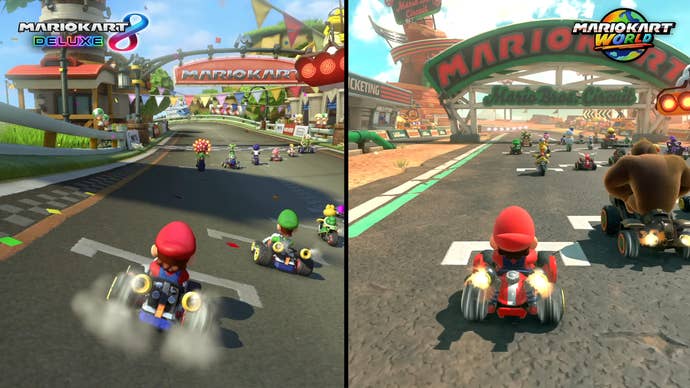
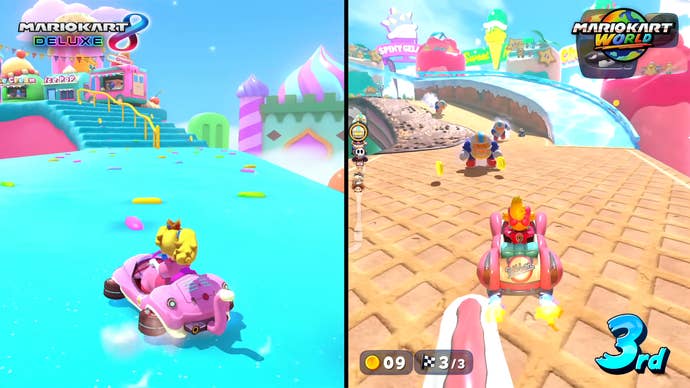
Beyond the game’s core visual makeup, we should discuss the title’s basic rendering parameters. In World’s default visual mode in docked play, current media suggests a 1440p image in all my counts without TAA or temporal upsampling. It’s a little hard to offer a precise sense of image quality, given that all the extended footage we have is ripped from Nintendo Treehouse playthroughs, but I think it generally looks fine enough. Relying so heavily on baked lighting minimises aliasing gremlins in typical play.
All the material we have so far suggests a 60fps refresh, which is maintained faultlessly. The game’s photo mode runs at a more modest 30fps update, however. There’s also apparently a 120fps mode, though we don’t have any capture of it at the moment. Split-screen play is also included here, at least for race events. The same 60fps update is evident, at least for two-player split-screen play. We don’t have any footage of four-player splitscreen, though the Nintendo Treehouse footage features two consoles running with two-player splitscreen put side-by-side.
Nintendo’s GameChat functionality is supported here as well, like with every other Switch 2 title, and it does seem like a neat addition. The roughly 8fps camera feed is mildly distracting, and perhaps better suited for a slower-paced title, but I think the overall effect is pretty cool, and the real-time background removal works pretty well. Obviously, comparisons with streaming suites available on PC are probably not particularly flattering – but for something integrated into a low-power console platform with a limited slice of GPU time, I think it’s a neat option for party play.
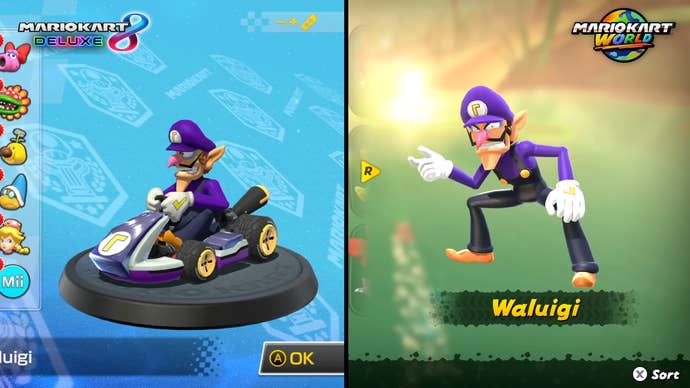
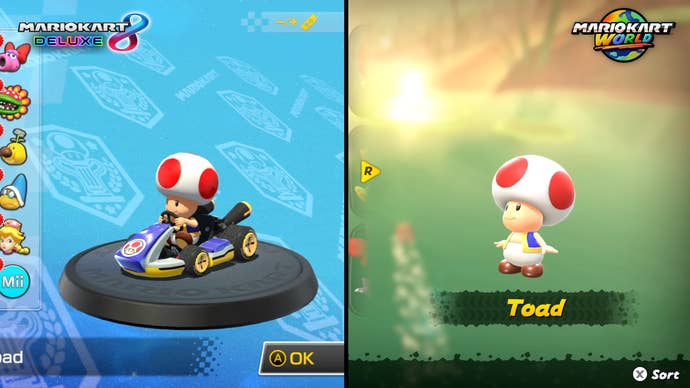
Mario Kart World is in some respects an iterative upgrade over Mario Kart 8, but the extra horsepower has been put to good use to enable 24-player races and a vast open world. There are some key visual upgrades in the mix too, and resolution gets a bump, along with the maximum supported frame-rate. That’s a really solid mix for a big new next-gen Nintendo game, especially one arriving so early in the Switch 2’s lifecycle.
I think Nintendo ran into a big issue when they sketched out the concept for World. Mario Kart 8 was such a tight, perfectly tuned game, had already explored transforming vehicles, and came loaded with content. It’s a very hard game to top on its own terms. With World, Nintendo hasn’t really tried to, instead veering off in a very different direction in gameplay terms – even beyond the obvious shifts to scope. The changes are numerous: tracks are wider, handling is a little looser and mini-turbos charge more slowly, items have been tweaked, automatically trail the player, and have generally been made less punishing, gliders have been replaced with wings, watercraft have been introduced, it’s possible to trick off the ground, and there are new rail grinding and wall riding mechanics.
Even though we have a fair bit of off-screen and direct-feed footage of the game, the intricacies of these mechanical changes aren’t fully understood. Some mechanics, like ground tricking and wall riding, will hopefully be balanced carefully to avoid degenerate gameplay. It looks like fun to me, but it also looks like it will take a bit of getting used to coming off of 8.
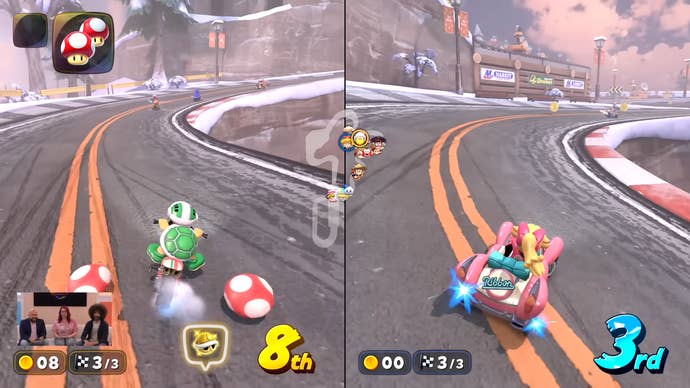
I do share certain community concerns though about the game’s gameplay structure. The Grand Prix and Knockout Tour modes take you through long stretches of track between individual circuits, which definitely has some appeal and sells the open-world fantasy. But these highway segments have long straights, few turns, and don’t look as interesting as the actual proper circuits. Of course, I haven’t played the game, and it could just be the case that less twisting tracks remain interesting because of boost pads, traffic, and 24 player play. 200cc racing speeds could help, though it hasn’t been confirmed as an option, and neither has mirror mode.
But on the flipside, the game’s new open-world structure seems like it could introduce a lot of opportunities for interesting single-player gameplay. A mix of challenges, races, and collectables would be nice here – perhaps taking some cues from Forza Horizon. Nintendo is keeping their cards close for now, but they are hinting at some exciting possibilities. As someone who mostly enjoys Mario Kart offline, I think these bits of open-world fun could keep me returning for many months to come.
